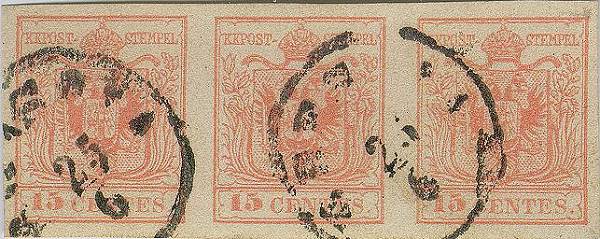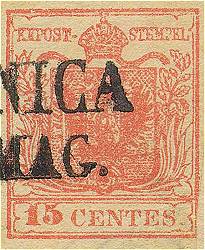15
CENTESIMI

As for the 10 centesimi, even this stamp
was printed both on hand-made paper as well as machine-made paper (from 1854),
with thickness and quality very variable, using both the "original"
coat of arms as well as the "revisited" one (see the issue
introduction and the "Going deep" section).
As for other values of this set it is possible to recognize the pieces printed
with the first matrix that present the second "K" of KKPOST"
defective and the first "E" of STEMPEL" incomplete at bottom
(Fig. 1). Because the defects were quite visible the Vienna printing
house decided to change quickly this matrix and, to save time, took the minting
die of the 10 centesimi and substituted the "0" with a "5".
It's possible to prove it by noticing as this second matrix (called by somebody
"first matrix -second variation") show the characteristic
sign of the first matrix of the 10 centesimi, that is the tilted sign on the
external right side of the coat of arms at 2 mm from the top (Fig. 1a).
It was used to print the 2nd type and part of the pieces of the third type
(see later on).
.

Fig. 1: 'K' defective and
'E' incomplete

Fig. 1a: color trait at right
We
can identify three main sub-types of the 15 centesimi; to be a bit more accurate,
do exist several constant varieties of the various sub-types but their classification
would be too large and too technical. It is therefore left to the specialists
of the matter. To whom who wants to go in more details on the several sub-varieties
of this stamp, I suggest the material present in the "Bibliography"
section.
I will limit myself to describe only the three main types (outlining only
the main recognition elements), as it is described in most of the Italian
specialized catalogues.
1st
TYPE: number "5" shifted from the upper
label; second "K" of "KKPOST" defective and similar to
a "F"; first "E" of "STEMPEL" incomplete at
bottom; tip of the lower internal right ornament long and pointed; "S"
of "CENTES" that ends before the internal ornament tip; "C"
of "CENTES" slightly deformed due to a color dot in the lower curve
(Fig. 2).

Fig. 2: first type
2nd
TYPE: "K" of "KKPOST" and
"E" of "STEMPEL" complete and regular; number "5"
attached to the upper label and closed by a color dot; tip of the lower internal
right ornament long and pointed, as in the first type; "S" of "CENTES"
that ends exactly under the internal label tip. Two sub-types exist: the first
one with the second "E" of "CENTES broken at bottom and the
second one with the same letter complete (Fig. 3).

Fig. 3: second type, 2nd sub-type
NOTE:
just a clarification. Usually two stamps of this type are classified. Even
with identical characteristics they differ for their quite different color
shades; one is vermilion red (the rarest) and the other is pink. I show here
the two stamps just to allow everybody to see the quite evident color difference
(Fig. 3a-3b).
|
|
|
|
|
Fig.
3a: vermilion red
|
|
Fig.
3b:
pink
|
3rd
TYPE: differently from the 2nd type, the number
"5" is attached to the upper label but open; tip of the lower internal
ornament short and flat; the pieces on machine-made paper are always of this
type (Fig. 4).
(NOTE: two sub-types do exist of this value. They differ
by very minimal drawing details. I leave to the collectors, as always, the
pleasure of the study...)

Fig. 4: third type
Catalogued color shades (as per Sassone) - 1st type, hand-made paper
Red (typical color)
Red (first issue)
Carmine red (first issue)
Carmine red
Vivid carmine red
Vermilion red
Pale vermilion red
Deep vermilion red
Dark vermilion red
Catalogued
color shades (as per Sassone) - 2nd type hand-made paper
Vermilion red (typical
color)
Pale vermilion red
Deep vermilion red
Dark carmine red
- - - - - - - - - - - - - - - - -
Pink (typical color)
Carmine pink
Deep carmine pink
"Carnicino" (Skin type") pink
Catalogued color shades (as per Sassone) - 3rd type hand-made paper
Red (typical color)
Pale red
Deep red
Pink red
Salmon red
Salmon pink
Pale salmon red
Deep salmon red (confuse printing)
Pale carmine red
Carmine red
Deep carmine red
Catalogued
color shades (as per Sassone) - 3rd type machine-made paper
Vermilion red (typical
color)
Pale vermilion red
Salmon red
Vermilion pink
Salmon pink
Pale pink







